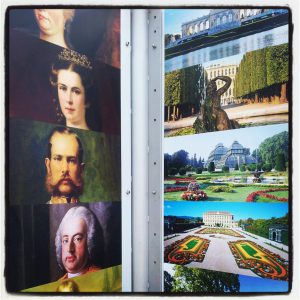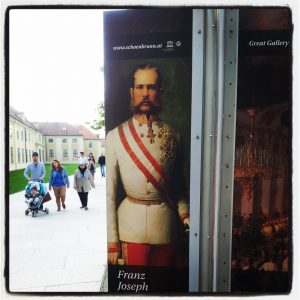Vienna’s Sisi Museum in the Hofburg Palace
By Tracy A. Burns
 Vienna’s Hofburg Palace has housed the government of empires and republics since 1279 and has been the residence of Austrian leaders for more than six centuries. It has 18 wings, 19 courtyards, and 2,600 rooms. The Imperial Apartments and Sisi Museum are sights not to be missed in this complex. The Sisi Museum features more than 300 items that belonged to the empress. The furnishings of the apartments are in Revival Rococo style, dating from the second half of the 19th century. Emperor Franz Joseph and Empress Elisabeth, often referred to fondly as Sisi, moved there in 1857.
Vienna’s Hofburg Palace has housed the government of empires and republics since 1279 and has been the residence of Austrian leaders for more than six centuries. It has 18 wings, 19 courtyards, and 2,600 rooms. The Imperial Apartments and Sisi Museum are sights not to be missed in this complex. The Sisi Museum features more than 300 items that belonged to the empress. The furnishings of the apartments are in Revival Rococo style, dating from the second half of the 19th century. Emperor Franz Joseph and Empress Elisabeth, often referred to fondly as Sisi, moved there in 1857.
Emperor Franz Joseph and Empress Elisabeth
 Franz Joseph was crowned emperor when he was just 18 years old and would become the most respected and most beloved member of the Habsburg dynasty, ruling the Austrian Empire and then Austro-Hungarian Empire for 68 years, third-longest reign in the history of Europe. He fell in love with Elisabeth when she was only 15 years old and married her in 1854. However, the marriage was fraught with both political and personal tensions. Elisabeth abhorred the strict regimen and ceremony of royal life and withdrew from society, defying Habsburg protocol. She often traveled, wrote poetry, and focused on beauty and exercise. Sisi was the longest reigning Austrian empress, holding that position for 44 years. While the empress and her lady-in-waiting were walking along the promenade in Geneva on September 10, 1898, the 25-year-old Italian anarchist Luigi Luccheni fatally stabbed her in the heart with a sharpened needle file.
Franz Joseph was crowned emperor when he was just 18 years old and would become the most respected and most beloved member of the Habsburg dynasty, ruling the Austrian Empire and then Austro-Hungarian Empire for 68 years, third-longest reign in the history of Europe. He fell in love with Elisabeth when she was only 15 years old and married her in 1854. However, the marriage was fraught with both political and personal tensions. Elisabeth abhorred the strict regimen and ceremony of royal life and withdrew from society, defying Habsburg protocol. She often traveled, wrote poetry, and focused on beauty and exercise. Sisi was the longest reigning Austrian empress, holding that position for 44 years. While the empress and her lady-in-waiting were walking along the promenade in Geneva on September 10, 1898, the 25-year-old Italian anarchist Luigi Luccheni fatally stabbed her in the heart with a sharpened needle file.
The Sisi Museum
Before touring the Imperial Apartments, visitors reach the intriguing Sisi Museum. Opened to the public in 1994, this museum shows off Sisi’s death mask, the file with which she was stabbed, her traveling medicine chest, parasols, and gloves, for instance. The black coat the empress was covered with after the assassination is also on display.
Coronation gown, mourning jewelry, and more
Visitors see a replica of Sisi’s exquisite coronation gown as Queen of Hungary. The silver brocade gown is trimmed with lace and has a midnight blue velvet bodice. The mourning jewelry she wore after her son Crown Prince Rudolf committed suicide in 1889 is part of the exhibition as well. Sisi loved to travel by train, and tourists can view a replica of her sleeping car.
The Imperial Apartments: Franz Joseph’s Apartments
The Imperial Apartments are divided into those for Franz Joseph and those used by Empress Elisabeth. First, visitors enter the section of the residence where Franz Joseph spent most of his time. Three huge paintings with political themes decorate the Audience Waiting Room, where the emperor met with citizens twice a week for several minutes at a time, usually seeing more than 100 subjects in one day.
The Conference Room, Study, and Large Salon
The Conference Room features two large paintings of battle scenes from the Hungarian Revolution of 1849. Take a close look at the Study, where Franz Joseph started work every morning at 4 am. In the Large Salon are writings by Crown Prince Rudolf called Kronprinzenwerk. In these works the Crown Prince expressed his political views – so adamantly different from his father’s – and described lands in the empire.
Empress Elisabeth’s Apartments
This section is where Empress Elisabeth lived from 1857 until her death in 1898. In the Living Room, which also served as her bedroom (the couple had separate bedrooms as of 1870), visitors can see Sisi’s original writing desk and a Neo-Gothic altar. In the Dressing Room / Exercise Room Sisi had her long hair brushed and styled for two hours, starting at six in the morning, while she devoted her time to learning languages. The walls are decorated with portraits of people whom she held dear, including members of her family as well as her favorite poet, Heinrich Heine.
The Bergl Rooms and more
The Bergl Rooms, named after the north Bohemian artist who decorated them, are perhaps the most beautiful spaces in the apartments with murals of idyllic landscape scenes gracing the walls. In the Large Anteroom, visitors see paintings of Empress Maria Theresa’s children acting, dancing, and singing.
The Alexander Apartments
The Alexander Apartments take their name from Tsar Alexander I of Russia, who stayed there during the Congress of Vienna in 1815. The Red Salon or Boucher Room dazzles with 18th-century tapestries from Paris. Notice the ornate upholstery on the chairs and fire screens. Step into the Dining Room and imagine Emperor Franz Joseph seated in the center at a formal dinner for 30 people. Imagine bouillon being served before oysters, salad, fish, and meat in a seven- to 13-course meal.
The Imperial Silver Collection
The Imperial Silver Collection is part of the tour, too. Don’t miss the Gothic-style dessert service adorned with portraits of Habsburg rulers. The Sèvres service featuring green ribbons was a gift from King Louis XV of France to Empress Maria Theresa in the 1750s. Take a look at exquisite soup tureens, stands for sweets, duck squeezers, consommé cups, samovars, Imari porcelain, and table centerpieces.



